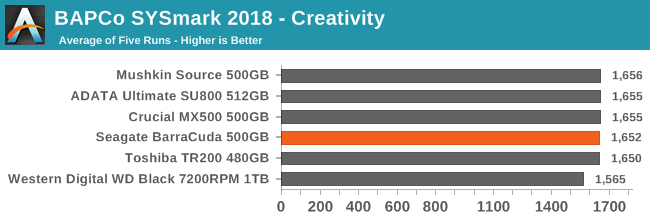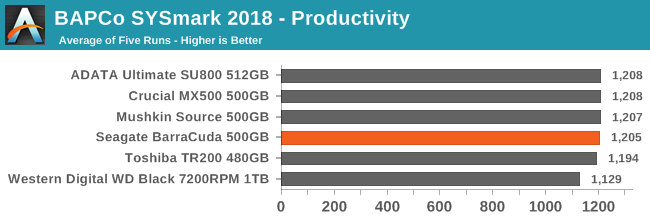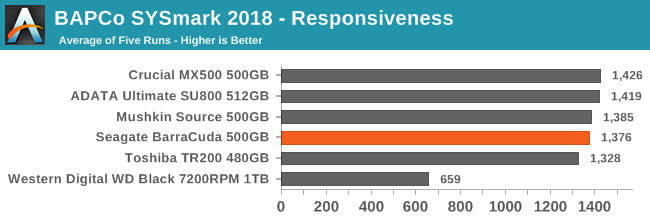The Seagate BarraCuda (500GB) SSD Review: Getting Back In The Game
by Billy Tallis on December 7, 2018 8:00 AM ESTWhole-Drive Fill
This test starts with a freshly-erased drive and fills it with 128kB sequential writes at queue depth 32, recording the write speed for each 1GB segment. This test is not representative of any ordinary client/consumer usage pattern, but it does allow us to observe transitions in the drive's behavior as it fills up. This can allow us to estimate the size of any SLC write cache, and get a sense for how much performance remains on the rare occasions where real-world usage keeps writing data after filling the cache.
 |
|||||||||
The SATA bottleneck renders the SLC caching behavior of the Seagate BarraCuda largely irrelevant for sequential writes. Aside from a momentary blip around the 4GB mark, the BarraCuda stays near the limits of the SATA link for the entire drive filling process.
 |
|||||||||
| Average Throughput for last 16 GB | Overall Average Throughput | ||||||||
The Seagate BarraCuda isn't quite able to match the fastest SATA SSDs for sustained write speed, but it is less than 5% slower. Drives with Silicon Motion's 4-channel SATA SSD controllers have shown that there's no real need for 8-channel controllers in the SATA space anymore, but the 8-channel design of the Phison S10 does convey some fringe benefits as seen here.
BAPCo SYSmark 2018
BAPCo's SYSmark 2018 is an application-based benchmark that uses real-world applications to replay usage patterns of business users, with subscores for productivity, creativity and responsiveness. Scores represnt overall system performance and are calibrated against a reference system that is defined to score 1000 in each of the scenarios. A score of, say, 2000, would imply that the system under test is twice as fast as the reference system.
SYSmark scores are based on total application response time as seen by the user, including not only storage latency but time spent by the processor. This means there's a limit to how much a storage improvement could possibly increase scores, because the SSD is only in use for a small fraction of the total test duration. This is a significant difference from our ATSB tests where only the storage portion of the workload is replicated and disk idle times are cut short to a maximum of 25ms.
| AnandTech SYSmark SSD Testbed | |
| CPU | Intel Core i5-7400 |
| Motherboard | ASUS PRIME Z270-A |
| Chipset | Intel Z270 |
| Memory | 2x 8GB Corsair Vengeance DDR4-2400 CL17 |
| Case | In Win C583 |
| Power Supply | Cooler Master G550M |
| OS | Windows 10 64-bit, version 1803 |
Our SSD testing with SYSmark uses a different test system than the rest of our SSD tests. This machine is set up to measure total system power consumption rather than just the drive's power.



The Seagate BarraCuda provides adequate performance for the CPU and memory-bound Creativity and Productivity scenarios, but on the Responsiveness test it comes up a bit short of what a mainstream SATA SSD should deliver. Instead, it scores more in line with the DRAMless SATA SSDs, which is still far better than a 7200RPM hard drive.
Energy Usage
The SYSmark energy usage scores measure total system power consumption, excluding the display. Our SYSmark test system idles at around 26 W and peaks at over 60 W measured at the wall during the benchmark run. SATA SSDs seldom exceed 5 W and idle at a fraction of a watt, and the SSDs spend most of the test idle. This means the energy usage scores will inevitably be very close. A typical notebook system will tend to be better optimized for power efficiency than this desktop system, so the SSD would account for a much larger portion of the total and the score difference between SSDs would be more noticeable.

The overall system energy usage during SYSmark is reasonably low for the Seagate BarraCuda, indicating that the slightly lower performance of the BarraCuda doesn't add much to the overall runtime of the test. The good active idle power management (see page 9) also contributes to this good score.










39 Comments
View All Comments
automator_devops - Friday, December 7, 2018 - link
Looking forward to these being the first SSDs exhibiting the "click of death". Makes no sense I know, low quality humor. I actually do have a Seagate Archive 8TB in my case.Donkey2008 - Thursday, December 13, 2018 - link
If any manufacturer could accomplish this it would definitely be Seagate. They are the Hynix of hard drives - Mostly OEM, not reliable and shockingly still in business. I wouldn't buy anything from that company if my life depended on it.Donkey2008 - Thursday, December 13, 2018 - link
Oh, and I laughed when I first read your comment :-)aylak - Friday, December 7, 2018 - link
I owned several mechanical hard drives from Seagate and all of the failed at some point. I know it doesn't mean that their SSD drives will be as unreliable but it is funny that first thing came to my mind is this as I saw the title.Alim345 - Saturday, December 8, 2018 - link
There was one particularly unreliable series of those hard drives. Also HDD are not absolutely reliable and will inevitably fail after some timeBeaver M. - Wednesday, December 12, 2018 - link
Indeed. Yet Seagate wasnt very good at that either. They had far higher failure rates than WD and even Samsung (which also werent great).But its good to see that this seems to have changed. At least with their bigger drives. They seem to be on par with WD now, but WD isnt as good as it was a few years ago. I guess this HDD cartel made them sloppy.
Thats why I bought a Toshiba and HGST (shortly before they rebranded them as WD).
KAlmquist - Sunday, December 9, 2018 - link
When it was an independent company, Sandforce never demonstrated the ability to effectively test and debug their products. So the good think about Seagate going with a time-tested Toshiba controller is that it's possible to buy these drives and be confident that they will work correctly. If Seagate drops the price to the point where these drives represent a good value for the money, I would have no problem recommending them.III-V - Sunday, December 9, 2018 - link
Bit hard to read the article title on the front page -- white text on white photo doesn't really work!Billy Tallis - Monday, December 10, 2018 - link
There's supposed to be a partially transparent dark overlay at the bottom of the photo to serve as a background for the title text. Try re-loading the page, and if it still doesn't render, send us a bug report with a screenshot.